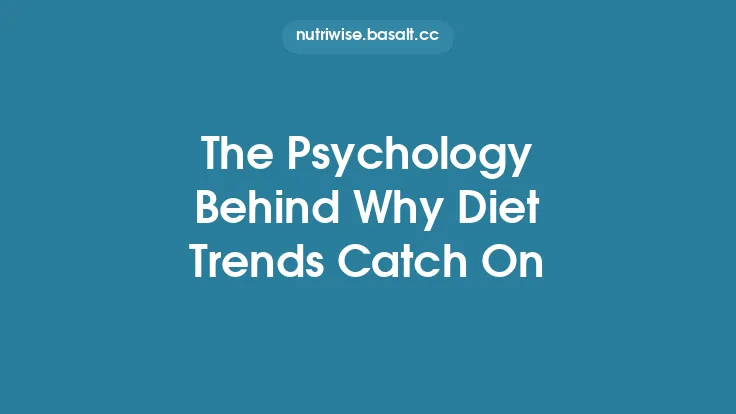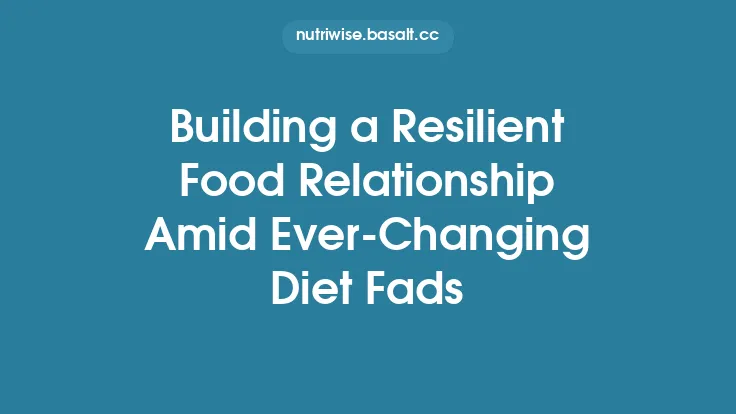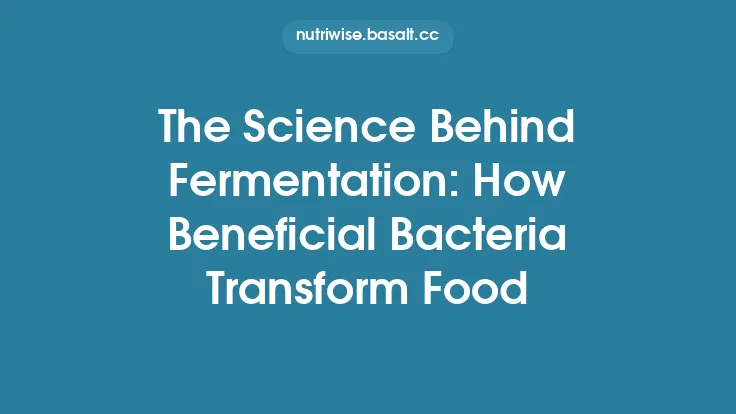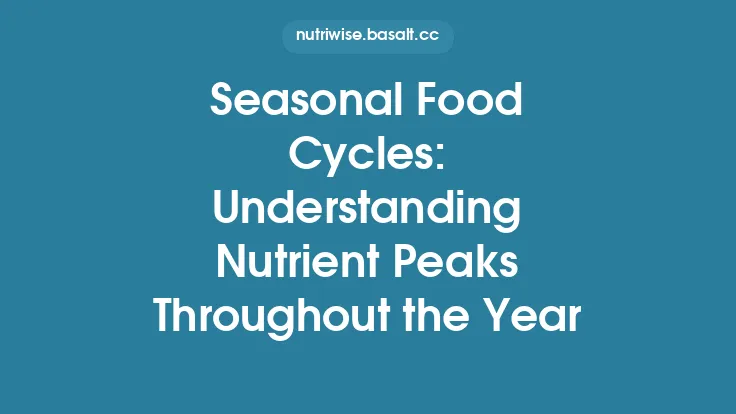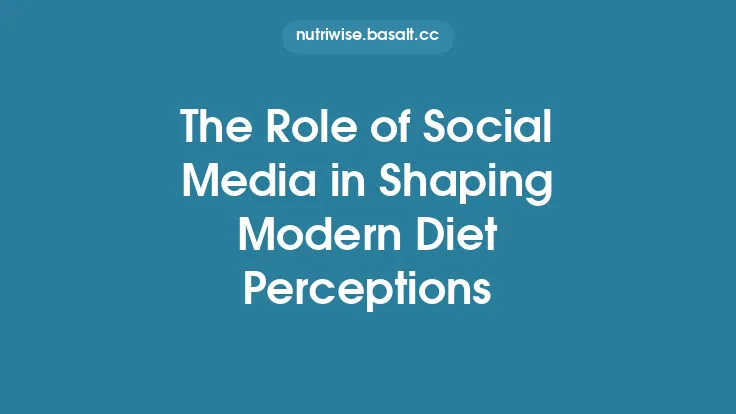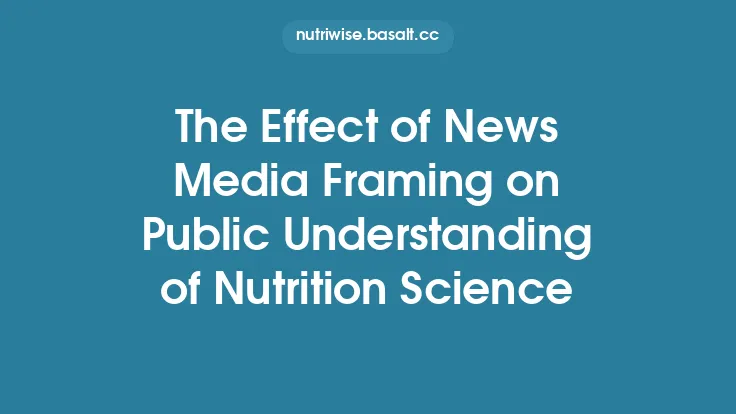The modern food landscape is saturated with headlines proclaiming the next “miracle” diet, the “super‑food” that will transform your health, or the “detox” trend that promises rapid weight loss. While the specific claims change with each passing season, the underlying psychological mechanisms that make these media‑driven food fads so compelling remain remarkably consistent. Understanding these mechanisms is essential for anyone who wishes to navigate the ever‑shifting world of diet information with a clear, evidence‑based perspective.
The Foundations of Human Food Perception
Human beings have evolved in environments where food scarcity and safety were constant concerns. This evolutionary backdrop has wired our brains to prioritize certain cues:
- Caloric Density Detection – Early humans needed to identify foods that provided the most energy per bite. Modern media exploits this by emphasizing “high‑protein,” “low‑calorie,” or “fat‑burning” attributes, tapping into an ancient drive to maximize energy intake while minimizing effort.
- Safety Heuristics – The brain’s amygdala monitors for potential toxins. Foods presented as “clean,” “organic,” or “free from additives” are perceived as safer, even when scientific evidence does not support a meaningful health advantage.
- Taste‑Reward Pathways – Dopaminergic circuits reward the anticipation of palatable foods. Media that promises “delicious yet healthy” meals leverages this reward system, creating a mental shortcut that equates taste satisfaction with nutritional benefit.
These foundational processes are not inherently flawed; they simply provide a fertile ground for media messages to attach themselves to deep‑seated psychological drives.
Cognitive Biases that Fuel Food Fads
A suite of well‑documented cognitive biases amplifies the impact of media messages about diet:
- Confirmation Bias – Individuals preferentially seek, interpret, and remember information that aligns with pre‑existing beliefs about health. When a media outlet touts a new “super‑food,” readers who already favor natural or alternative nutrition are more likely to accept the claim without critical scrutiny.
- Availability Heuristic – The ease with which examples come to mind influences perceived frequency. Repeated exposure to headlines about “keto success stories” makes the diet seem more common and effective than epidemiological data would suggest.
- Bandwagon Effect – The perception that many others are adopting a particular diet creates a social proof loop. Media coverage that highlights “millions trying the paleo lifestyle” can trigger a self‑reinforcing surge in adoption, independent of scientific validation.
- Illusory Correlation – People often link unrelated events when they occur simultaneously. A celebrity’s weight loss after a media‑promoted diet can be mistakenly attributed to the diet itself, ignoring confounding factors such as exercise, genetics, or caloric restriction.
- Optimism Bias – Individuals tend to overestimate the likelihood of positive outcomes for themselves while underestimating risks. Media narratives that promise rapid health improvements exploit this bias, leading readers to believe they will experience the “best‑case scenario” of any diet.
Understanding these biases equips readers to recognize when a media story is playing on mental shortcuts rather than presenting balanced evidence.
Social Influence Mechanisms in Media Contexts
Beyond individual cognition, media operates as a conduit for broader social influence:
- Social Identity Theory – People derive part of their self‑concept from group memberships. Media that frames a diet as part of a “community” (e.g., “the vegan movement”) can attract individuals seeking belonging, even if the nutritional merits are marginal.
- Normative Social Influence – The desire to conform to perceived norms drives behavior. When media repeatedly presents a diet as the “new normal,” individuals may adopt it to avoid social exclusion, regardless of personal health considerations.
- Diffusion of Innovations – Everett Rogers’ model describes how new ideas spread through “innovators,” “early adopters,” and “laggards.” Media often targets the early adopter segment with compelling stories, accelerating the diffusion curve and creating the illusion of rapid, widespread acceptance.
- Authority Heuristics – Audiences tend to trust information presented by perceived experts. Even when a media piece cites a “nutritionist” without verifying credentials, the mere presence of an authority figure can lend undue credibility to the claim.
These mechanisms illustrate that media influence is not merely a one‑way transmission of facts; it is an interactive process that reshapes social norms and identity constructs around food.
The Role of Narrative and Storytelling
Humans are innately attuned to stories. Narrative structures provide context, emotional resonance, and memorability that raw statistics cannot achieve. Media leverages storytelling in several ways:
- Transformation Arcs – Articles often follow a protagonist who experiences a dramatic health turnaround after adopting a new diet. This arc mirrors classic hero journeys, making the message more compelling and easier to internalize.
- Anecdotal Evidence – Personal testimonies are vivid and relatable, but they lack the rigor of controlled studies. The vividness effect ensures that a single striking anecdote can outweigh a body of contradictory data in the public mind.
- Metaphorical Framing – Describing a diet as a “cleanse” or a “reset” invokes familiar concepts of purification, tapping into cultural narratives about health and morality.
- Temporal Sequencing – Media often presents a diet’s benefits as immediate (e.g., “lose 5 pounds in a week”), which aligns with the human preference for short‑term rewards over long‑term gains.
By embedding dietary claims within narratives, media transforms abstract nutritional concepts into concrete, emotionally charged experiences that are more likely to be remembered and acted upon.
Visual and Sensory Appeal in Media Messaging
The visual dimension of media is a powerful, often underappreciated driver of food fads:
- Color Psychology – Bright, saturated colors (e.g., vibrant greens for “super‑greens”) signal freshness and health, even when the underlying food composition is unchanged.
- Food Photography Techniques – Shallow depth of field, strategic lighting, and stylized plating make dishes appear more appetizing, reinforcing the belief that the food is both tasty and beneficial.
- Infographics and Data Visualization – Simplified charts that highlight a single positive statistic (e.g., “30% increase in metabolism”) can create a perception of scientific backing, despite the omission of methodological limitations.
- Sensory Language – Descriptive adjectives (“crunchy,” “silky,” “zesty”) engage the brain’s gustatory and olfactory cortices, eliciting imagined taste experiences that can bias judgment before actual consumption.
These visual and linguistic cues activate neural pathways associated with reward and anticipation, making the media message more persuasive than text alone.
Emotional Triggers and Fear of Missing Out
Emotions are the engine of decision‑making. Media outlets frequently harness specific emotional triggers to accelerate the adoption of food trends:
- Fear of Missing Out (FOMO) – Headlines that suggest a diet is “the next big thing” or that “everyone is switching to X” create urgency, prompting readers to act quickly to avoid being left behind.
- Anxiety Reduction – In times of health uncertainty (e.g., during a pandemic), media that offers a clear, simple dietary prescription can alleviate anxiety, even if the prescription lacks scientific support.
- Hope and Optimism – Promises of “reversing aging” or “boosting immunity” tap into deep‑seated hopes for control over one’s health trajectory, making the associated diet appear as a beacon of possibility.
- Moral Elevation – Framing a diet as ethically superior (e.g., “plant‑based for a kinder planet”) can invoke moral emotions, encouraging adoption for reasons beyond personal health.
These emotional levers often bypass analytical processing, leading to rapid, intuitive acceptance of dietary claims.
The Lifecycle of a Food Fad: From Emergence to Decline
While media can ignite a food trend, the trajectory of a fad typically follows a predictable pattern:
- Incubation – A novel food or dietary concept appears in niche publications, scientific abstracts, or cultural sub‑groups. Early adopters experiment and share experiences.
- Amplification – Mainstream media picks up the story, often simplifying complex findings into catchy slogans. Visuals, anecdotes, and expert quotes are amplified across platforms.
- Peak Adoption – The diet reaches mass awareness. Commercial products, cookbooks, and ancillary services (e.g., coaching) proliferate, reinforcing the trend’s visibility.
- Saturation and Scrutiny – As the market becomes saturated, critical voices emerge. Peer‑reviewed studies, meta‑analyses, and investigative journalism begin to highlight limitations, side effects, or lack of efficacy.
- Decline – Public interest wanes as newer trends emerge. The diet may persist in a niche form, but its mainstream prominence diminishes.
Understanding this cycle helps consumers anticipate when a diet is likely in the “hype” phase versus when it has withstood rigorous evaluation.
Implications for Public Health and Consumer Decision‑Making
The psychological potency of media‑driven food fads carries tangible consequences:
- Nutrient Imbalance – Rapid adoption of restrictive diets can lead to deficiencies (e.g., low iron in overly restrictive vegan trends) if not properly balanced.
- Economic Impact – Consumers may allocate disproportionate resources to specialty foods or supplements, diverting funds from evidence‑based health interventions.
- Behavioral Entrenchment – Once a fad becomes part of an individual’s identity, abandoning it can be psychologically costly, potentially leading to disordered eating patterns.
- Policy Considerations – Public health agencies must recognize the role of media psychology when designing communication strategies, ensuring that messages counteract bias rather than merely presenting data.
A nuanced appreciation of these implications can guide both individual choices and broader health policy.
Future Directions: Toward a More Resilient Food Perception Landscape
To mitigate the sway of fleeting media trends while preserving the benefits of rapid information dissemination, several avenues merit exploration:
- Pre‑Bunking Interventions – Exposing audiences to the tactics used in media persuasion before they encounter a fad can inoculate them against undue influence, a strategy supported by inoculation theory.
- Narrative Counter‑Messaging – Crafting compelling stories that emphasize balanced nutrition, long‑term health, and realistic outcomes can compete with sensationalist fad narratives.
- Multimodal Education – Integrating visual, auditory, and interactive elements in nutrition education can strengthen analytical processing and reduce reliance on heuristic shortcuts.
- Collaborative Fact‑Checking – Partnerships between scientific institutions, journalists, and technology platforms can streamline the verification of diet claims, reducing the latency between emerging evidence and public dissemination.
By aligning communication practices with the psychological realities of how people process food information, the ecosystem can evolve toward a more evidence‑grounded, less fad‑prone future.
In sum, media‑driven food fads are not merely the product of sensational headlines; they are the manifestation of deep‑rooted cognitive biases, social dynamics, emotional triggers, and storytelling techniques that have been honed over millennia. Recognizing the interplay of these forces equips individuals to navigate the ever‑changing diet landscape with a critical eye, fostering choices that are grounded in science rather than fleeting media allure.
